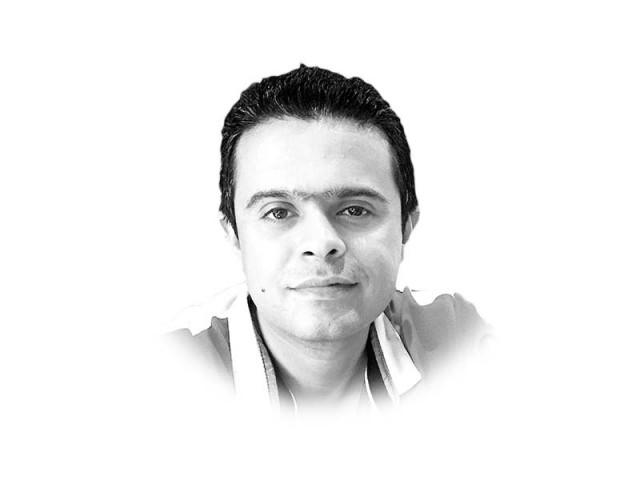Twitter and Pakistani politicians
Social media has taken our world by storm as the prime mode of communication

The writer is an honorary fellow of the Consortium for Development Policy Research and tweets at
@hasaankhawar
The most followed politicians on Twitter, in a descending order, include Imran Khan, Maryam Nawaz and Asad Umar with 5.52, 3.29 and 3.09 million followers, respectively. The next ones in the list are Punjab Chief Minister Shahbaz Sharif, Bilawal Bhutto, Bakhtawar Bhutto, Aseefa Bhutto and Jahangir Tareen. All these politicians have verified accounts. It must be noted that Prime Minister Nawaz Sharif and former president Asif Zardari have no official presence on Twitter.
These rankings, however, change when looked at from the perspective of how frequently do these politicians use Twitter. Considering that they all joined Twitter at various instances, their use is ranked on the basis of their tweeting rates. On this criterion, Maryam Nawaz tops the charts with 54,000+ tweets since January 2012, reflecting roughly 27+ tweets per day or 1+ tweet every hour. This is at least five times more than the next active politicians Asad Umar and Bilawal Bhutto, who have posted on average 5+ and 4+ tweets per day, since the time of their joining Twitter. Other politicians in order of ranking are Bakhtawar Bhutto, Shahbaz Sharif, Imran Khan, Aseefa Bhtto and Jahangir Tareen.
It is also quite interesting to compare the ‘tweet behaviour’ of these politicians besides the number of their followers. For this, I took a time slice and closely looked at a randomly selected Twitter week for all of them.
It turns out that Maryam Nawaz is by far the most engaging politician. If somebody mentions her in a tweet and requests something, she generally retweets the post and tags the relevant department or authority, urging them to handle the matter. She is also quite responsive to party supporters, who rally for PML-N’s cause and generally endorses or adds to their posts. Recently, when a supporter put up a picture of Nawaz Sharif with his sons arriving for the hearing and wrote “And the Sharifs stand united”, she immediately retweeted saying “his sons right behind him “.
The Zardari siblings, on the other hand, focus more on posting stuff regarding the legacy of their family, their troubles and political challenges. They also frequently make comparisons of hardships faced by PPP leaders compared to those of PML-N. Zardari’s sisters, along with Maryam Nawaz, also tweeted about Imran Khan’s dismal attendance in the National Assembly sessions.
During the week in question, Imran Khan mostly tweeted about the ongoing Panama case investigation followed by occasional posts related to the K-P police handling of Mashaal Khan case, quality of education in K-P schools, cricket, international politics, national economy and one time a quote by Lao Tzu, the ancient Chinese philosopher. He either retweeted some of his own posts or Jemima’s tweet about finding the bank documents.
Almost all politicians seem to use Twitter to publicise their performance, quoting articles or statistics. The provincial chief minister often retweets posts from the Punjab government, while Imran Khan frequently quotes performance of the K-P government. Aseefa and Bakhtawar on numerous occasions have posted reports showing how the polio threat has gone down in Sindh. However, very few political leaders were found to engage with adversaries and critics.
Twitter and other social media platforms have made politicians more accessible and accountable to citizens, sometimes making them victims to unpleasant trolls. But then why opt for social media and why not avoid it altogether?
Twitter is the key for politicians to endless publicity, a real-time handle on the political pulse and a unique opportunity to engage with friends and foes. Not only can they create headlines, with effective use of their tweets and potential reach of millions of followers, they can also have instant access to insights on what resonates with their voters. The smarter ones then immediately calibrate their response. With a bulging youth population and increasing penetration of Internet, the future political battles in Pakistan will be fought on social media and it is more of a necessity then a luxury for younger politicians.
But managing a vibrant social media presence is not easy. How can politicians use Twitter more effectively? More engagement and less broadcast, targeted campaigns and balanced messaging are three areas, where they should focus the most.
Firstly, more replies to supporters and critics mean more debate, more controversy and more publicity. People just don’t want one-sided communication. They want to engage. Politicians must remember that Twitter is not print media, radio or TV and rather a two-way medium. In fact, they should occasionally seek feedback on their agendas and run polls and crowd source ideas on issues of public importance.
Secondly, political leaders should take the driving seat and set the agenda for the media. Twitter provides them room to do that. They should run targeted campaigns, just like multinationals and citizen organisations make use of hashtag campaigns. The famous #ShareACoke and #IceBucketChallenge campaigns are a case in point. The key is to look for innovative means to enhance the reach and deepen its impact, through live question and answers] sessions, calls for action, live tweet events and feeding relevant and custom-built content.
Last but not the least, it is important for politicians to show their personal side and not just use Twitter for political messaging so that voters can better relate to them and they can potentially convert followers into voters and ardent supporters.
Published in The Express Tribune, June 22nd, 2017.
Like Opinion & Editorial on Facebook, follow @ETOpEd on Twitter to receive all updates on all our daily pieces.














COMMENTS
Comments are moderated and generally will be posted if they are on-topic and not abusive.
For more information, please see our Comments FAQ